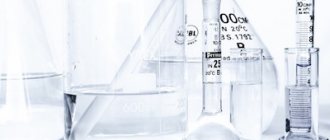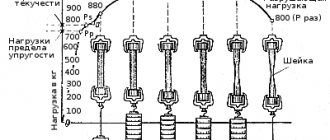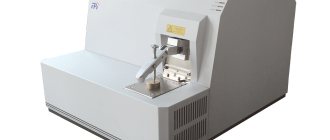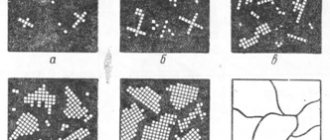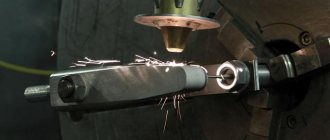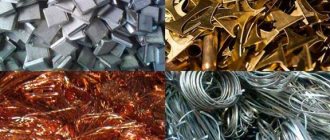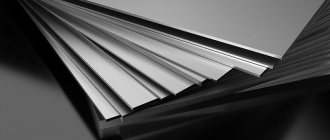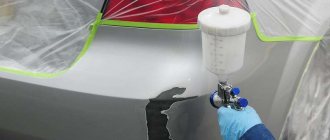offers services for various laboratory tests. Our capabilities include the latest technical means that allow us to determine materials, their composition and characteristics, the presence of impurities and additives with a high degree of accuracy. Qualified specialists perform analyzes based on impressive research experience. All this guarantees maximum reliability of the research performed.
Laboratory studies are carried out at the request of customers in order to determine the quality of materials. They indicate the objects under study and their main parameters.
Purpose
Chemical analysis allows:
- determine the quantitative composition;
- examine the sample for the presence of impurities and determine their concentration;
- identify the alloy;
- find out the ratio of alloy impurities for its marking.
The research is necessary for:
- examination of products to determine compliance with current standards;
- continuous monitoring of the technological process;
- incoming control of raw materials;
- development and creation of new alloys;
- product certification;
- inspection of pure metals.
In what cases is laboratory testing required?
Analyzing substances in a laboratory is an opportunity to identify their chemical composition, determine physical properties, and establish compliance or non-compliance with standards and technical norms. The procedures carried out by researchers make it possible to ensure the quality of the material being studied.
The service is ordered when disputes arise regarding the quality of materials, or if it is necessary to determine the characteristics of research objects. An expert opinion based on the results of the procedure serves as significant evidence both in court and in authorities whose powers include monitoring compliance with standards.
Methods of atomic emission spectral analysis
Atomic emission spectral analysis (AESA) of metals and alloys has become most widespread in various industries. With its help, you can examine substances in various states of aggregation for the presence of many chemical elements. It has a low detection limit of elements, is simple and low-cost, which makes it advisable to use it in laboratories for the spectral analysis of metals that solve various analytical problems.
The emission spectrum of a sample is recorded using a spectrograph, spectroscope or spectrometer. On this basis, all methods of conducting AESA are divided into the following three groups, each of which has its own specifics.
Spectrographic
It is carried out using a spectrograph, which allows you to obtain reliable results relatively quickly. The method involves recording atomic spectra on a photographic plate and then identifying them using a tablet or a spectroprojector.
Advantages:
- objectivity;
- documentary.
Flaws:
- labor intensity;
- low efficiency.
Spectrometric
To study the sample, instruments with photoelectric recording of the spectrum are used. This type of chemical analysis of metals and alloys is an objective method and allows you to quickly obtain information.
Advantages:
- expressiveness;
- high accuracy of results;
- complete automation of the process;
- processing of results on a computer and archiving them.
Flaws:
- complexity of equipment operation;
- the occurrence of problems of optical and electrical stability;
- it is impossible to simultaneously record a wide range of the spectrum.
Visual
It differs from the previous two in subjectivity, since the human eye serves as a radiation receiver. Despite its limited capabilities, visual spectral analysis is widely used in industry. The visual method acquires particular importance when it is necessary to control the chemical composition of alloy steels during their production.
Advantages:
- expressiveness;
- simplicity;
- carrying out analysis at the location of the samples;
- low cost of equipment.
Flaws:
- low accuracy of results;
- does not allow the determination of non-metallic elements.
Chemical examination
Liquids containing alcohol
. Quite common in forensic practice is the examination of various liquids, including alcohol-containing ones. Research is carried out to determine the characteristics of these substances, the presence of impurities, and their classification. Such an examination is often performed in criminal cases to prove the fact of poisoning or the manufacture of counterfeit products with a high concentration of harmful substances. Expert activities for the analysis of alcoholic beverages solve the problems of:
- identifying the percentage of alcohol;
- determining the strength of the product and establishing the manufacturing method;
- checking the conditions of storage, transportation, packaging;
- research of the quality of raw materials used for the production of drinks;
- adulteration of liquids.
Air examination
. The air may contain toxic substances that are harmful to human health. To get rid of the source of pollution, the air is first analyzed. As a result of research, experts are able to identify:
- volatile organic substances that are found in solvents, adhesives, and paints. They can lead to respiratory diseases;
- elements of heavy metals (cadmium, lead, mercury). These substances are harmful to health when they accumulate in the body;
- formaldehyde. This substance negatively affects vision and leads to a sore throat;
- hydrogen sulfide. This substance in high concentrations can cause pulmonary edema.
Cosmetics, perfumes
. The examination of cosmetics and perfumes is carried out: firstly, during the investigation of crimes, when it is necessary to look for traces of such products as evidence. Secondly, these funds are examined for the presence/absence of counterfeit goods. The objects of this type of examination are:
- lotions, perfumes, creams, eau de toilette;
- hair, nails, skin care products;
- decorative cosmetics, shaving products, toothpastes, mouthwashes;
- gels, shampoos, other cosmetic detergents.
The cosmetic market offers a huge range of products. Moreover, it is constantly updated with new groups of goods. These products are often produced in violation of standards or are counterfeited. The examination will help to identify a fake and determine the level of quality.
About chemical examination: what is it, features of the study
The research allows:
- Identify causal factors that lead to changes in the properties of the object being studied
- Conduct a comparative analysis of the chemical components that are actually part of the object
- Analyze the compliance of the results with those declared by the manufacturer
- Identify inconsistencies regarding the data stated within the regulatory documentation
- Classify the occurrence of chemical processes
Regardless of the goals pursued by the customer, the research and development center provides a wide range of services with an individual approach to each case at any level of complexity. Our team of specialists has enormous experience in conducting a variety of chemical studies - we use our acquired experience and our own developments to provide the customer with the most effective results.
When ordering chemical examination services in our research center, you are in direct contact with the experts who conduct the research. This allows us to provide clients with the most favorable price for the service, and also eliminates the occurrence of inaccuracies in the assigned tasks.
Chemical examination is carried out in specially equipped laboratories, which are equipped with a variety of modern equipment, the use of which allows us to cope even with tasks of increased complexity. Combined with the high qualifications of our specialists, this allows us to obtain the most accurate and objective results.
The conclusion of a chemical examination takes the form of a special protocol, in which the results of the study are presented in an accessible form, which even a “non-specialist” can understand. At the same time, the protocol is accompanied by links to the literature materials used, a list of methods, chromatograms and spectra. The validity of the examination is confirmed by the attachment of certificates and diplomas of the specialists who conducted the research.
Tasks of chemical examination
Chemical examination can solve many problems, including:
- study of alloys and metals and products made from them
- steel alloy grade identification
- comparison analysis of alloys and metals
- research of various products
- paints and varnishes and coatings with their application
- products made of plastic, rubber, polymer components
- medications and dietary supplements
- food additives aimed at vegetarians, athletes, people who support a healthy lifestyle
- petroleum products
- technical fluids for vehicles
- food, drinks
- containers made of polymer compounds
- identification of toxins, poisons, carcinogens and radioactive components
- study of environmental components
- conducting chemical analysis of concrete and cement-containing materials and structures using them
- classification of products relative to HS codes
- study of surface-active qualities of materials and components;
- flaw detection
- research of substances of unknown origin for quantitative and qualitative composition;
- setting the limitation period for signatures on documents
- studying the reliability of the examinations carried out and their validity
- review of drug and toxicological examinations
- performing tasks requiring extensive knowledge in the chemical industry
Metal Analyzers (Metal Spectrometers)
Metal analyzers from HITACHI
- these are devices that combine a combination of high reliability and analytical characteristics.
HITACHI
is the only manufacturer on the market that can provide a full line of analytical methods used in the industry for metal analysis - X-ray fluorescence analysis, optical emission spectroscopy and laser emission spectroscopy
.
Currently, more than 1,500 thousand industrial enterprises in Russia and the CIS countries are
users of equipment from HITACHI HITACHI
invests heavily in the development and development of new models of metal analyzers .
Chemical analysis of steel
Chemical analysis of steel is usually carried out in laboratory conditions, namely in the ANO Center for Chemical Expertise, in order to determine the suitability of steel materials for construction or operation.
Chemical analysis makes it possible to recognize the composition of steel and the concentration of specific substances in it: impurities, carbon, nitrogen, toxic and poisonous components and oxidizing additives. Methods for performing chemical analysis of steel
- Carbide analysis method, without preliminary taking of chip samples. The metal is melted in a hole made on a pipe in a paraffin barrel.
- Gravimetric method. The analysis carried out by this method is popular today, because it has been well studied by specialists. It consists in determining the exact weight of a steel sample and the mass of all impurities included in its composition.
- Titrimetric method. Just like the previous method, this one consists not only of determining the exact mass of steel and its individual components, but also of directly measuring the total volume. Based on this, the gravimetric and titrimetric methods received the popular name: “weight” and “volume”.
- The Hoare and Havenhand J method is based on determining the concentration of sulfur located on the surface of the metal. It, just like those described above, is quite common these days.
Chemical analysis of steel can also be carried out in the absence of specific data in the crane passport regarding the properties and functions of the steel structure. To do this, specialists take chip samples (up to 35 grams) from a well-cleaned surface to identify stressed components of the metal structure.
Source
Cost of services
The cost of laboratory testing is determined individually in each case. The price is influenced by the number of parameters studied in accordance with GOST requirements, the complexity and number of questions posed to specialists.
All research in PetroExpert laboratories is carried out by highly qualified specialists with experience and the necessary knowledge in the field of material properties.
We work with the assistance of the SERBALAB laboratory - this is a medical genetic center, the basis of which is high-quality diagnostics and competent genetic counseling.
Instruments for analyzing the chemical composition of metals
Currently, the following devices are most widely used:
- Steeloscopes
- Portable X-ray fluorescence spectrometers
- Portable laser spectrometers
- Optical emission spectrometers
Steeloscopes
Steeloscopes are the simplest spectral instruments. The essence of the method is the evaporation of metal under the action of a discharge and the operator observing the resulting glow. Based on the brightness of the spectral lines, one can judge the concentration of various elements. Steeloscopes are inexpensive, but working with them is quite complicated and requires special skills, training for which takes from several months to several years. In addition, steeloscopes are evaluative instruments; the results of the analysis depend on the subjective assessment of the operator. This feature does not allow the use of these devices in many technological processes when accurate data on the elemental composition of the metal is required.
Chemical analysis of metal products in Moscow
Today, it is extremely important for many companies in Moscow to periodically contact non-destructive testing laboratories. Analysis of the chemical composition of our own products allows us to resolve a number of operational problems that enterprises face. These include:
- Control of incoming raw materials;
- Analysis of materials during their production;
- Certification of finished products.
The latter is especially relevant in Moscow, since inspections of the company’s activities by the supervisory authorities of the Russian Federation have become much stricter in recent years. This means that receiving a test report for the chemical analysis of products and raw materials from a licensed non-destructive testing laboratory will be a significant guarantor of peace of mind during the operation of the enterprise. Our chemical expertise center in Moscow is happy to help you in this matter.
Returning to theory, let us turn directly to the types of control of chemical composition analysis. There are two of them:
- Destructive. As the name implies, its implementation is associated with extreme exposure to the sample, after which it becomes unusable. Typically, it is considered a priority for metallurgy and other types of industry, which often use steel and other metal alloys.
- Non-destructive. It is most preferable in relation to the physical and chemical state of objects that have already been in operation for a long period.
Also, speaking about the study of chemical composition, one cannot ignore the issue of spectral analysis methods:
The emission method involves studying an object by exposing it to high temperatures in order to evaporate the substance into plasma before exciting it with a light source.
- Absorption - differs from emission only in that a heated solid body or other object with continuous radiation is used as a light source.
The laboratory provides the following services:
- Development of new analysis methods
- Authentication of chemical substances.
- Determination of the content of heavy metals and organic volatile impurities
- Determination of the constituent components of a substance
- Confirmation or refutation of the presence of active components
- Carrying out a dissolution test and determining the disintegration period
- Confirmation or refutation of the declared composition
- Determination of purity and absence of foreign impurities
- Checking for compliance with GOST R and TR CU
Scope of application
Metallographic control is mandatory for those types of equipment where metal is exposed to high temperatures, critical pressure and aggressive environments. This includes installations, apparatus, pipelines and containers in the energy, oil and gas, chemical and nuclear industries. There are at least a dozen GOSTs that establish regulatory characteristics and procedures for the use of metallography, and an even larger number of industry instructions, methods and regulations. For example, metallographic methods for assessing the grain size of steel in high-pressure steam pipelines at power plants (t up to 600 ºC, P up to 200 atmospheres) are regulated by GOST-5639. And in the event of their emergency failure, the industry regulatory document prescribes mandatory metallographic control.
Have any of you ever encountered metallographic testing of welds? In what cases is this used and how do metallographic examinations relate to flaw detection? Please write about your experience in the comments to this article.
Methods of chemical analysis of metals
Analysis of the chemical composition can be carried out using both “wet chemistry” and instrumental methods. The “wet chemistry” method consists of preliminary dissolution of the sample and subsequent isolation of the required components (precipitation, electrochemical separation, etc.). Such analysis takes a lot of time, sometimes up to several days, and requires special education and highly qualified engineers. In contrast, instrumental methods performed on modern instruments allow analysis of the chemical composition of metals after short instruction and require only basic computer skills.
